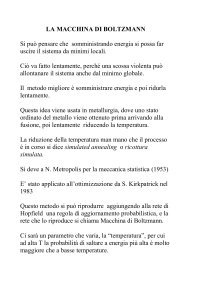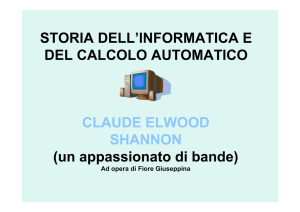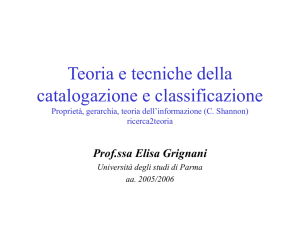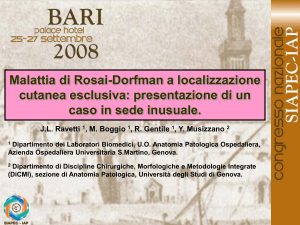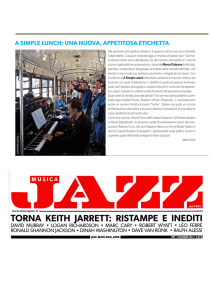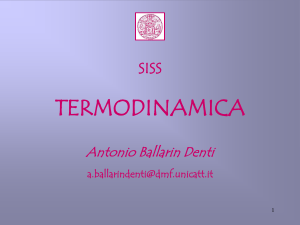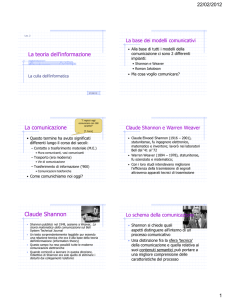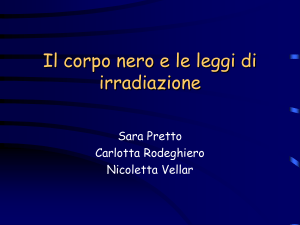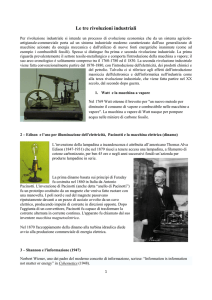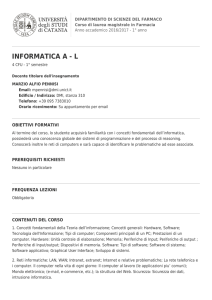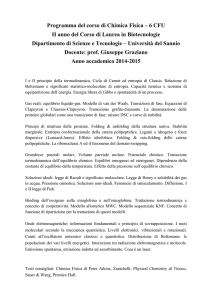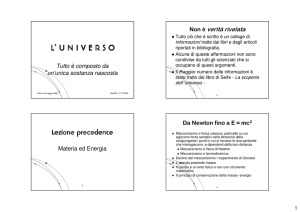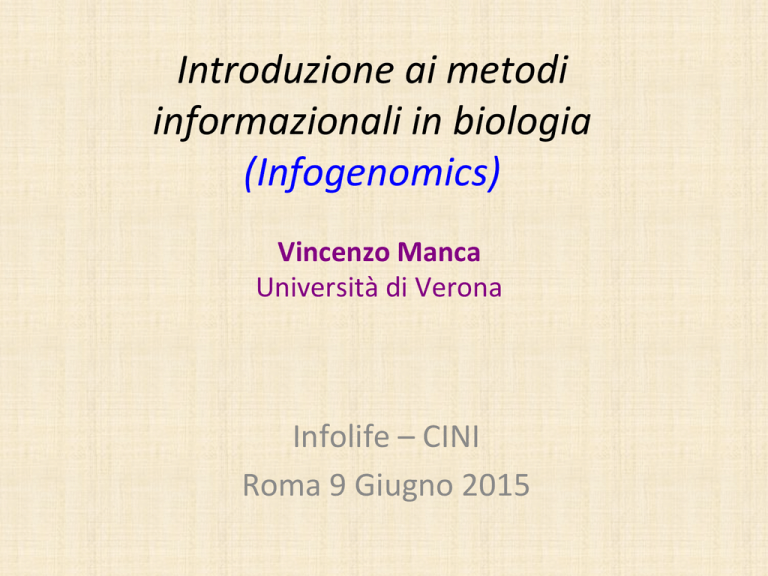
Introduzione ai metodi informazionali in biologia (Infogenomics) Vincenzo Manca Università di Verona Infolife – CINI Roma 9 Giugno 2015 Ringraziamen7 • Infolife/Infogenomics (Mondello meeCng) • My group (2009ècoll., post-­‐doc, Phd, ~ 10/15) – Vincenzo Bonnici (Post-­‐doc VR) – Giudi;a Franco (Ric. VR) – Alberto Castellini (Post-­‐doc Berlin (Potsdam), Max Plank) La vita è informazione rappresentata ed elaborata a livello molecolare. … “nasce” quando sono disponibili molecole in grado di rappresentare informazione e processi informaCvi (polimeri e membrane). Il calcolo simbolico (versus calcolo numerico/algebrico) è emerso nel 20° secolo per l’elaborazione formale (e poi automaCca) dell’informazione (Logica matemaCca e Calcolabilità). Due le scoperte fondamentali: 1) L’esistenza di processi matemaCcamente definibili, ma non calcolabili. LIMITI DEL CALCOLO 2) L’esistenza di macchine di calcolo universali, ovvero capaci di realizzare qualsiasi processo di calcolo. POTENZA DEL CALCOLO Riproduzione e Universalità • L’esistenza di macchine di calcolo “universali” è basata su algoritmi di duplicazione simbolica (un programma è il “mirror” di una machina entro un’altra). Analogamente, la riproduzione biologica postula meccanismi di duplicazione (ds DNA). DNA “more geometrico demonstratus” • La duplicazione template-­‐driven è realizzabile in tempo lineare. • Una struaura bilineare rende la duplicazione template-­‐driven più affidabile e veloce. Un polimero bilineare è astraaamente una sequenza di monomeri triangolari Non può rimanere su un piano NO Si avrebbero angoli concatenaCvi diversi a meno di non usare spirali logaritmiche Il parallelismo sarebbe possibile solo avendo molecole di chiralità diversa, ma questo complicherebbe notevolmente il processo di copia. Chiocciola di triangoli monomerici Phospho-­‐lipidic and Phospho-­‐diesteric Two forms of Bilinearity (based on chirality) lines of pairs and pairs of lines La sfera Il cilindro Manca – The logic of bilinear forms, Fundamenta InformaCcae, 2005 ******** Probabilità e informazione • Shannon 1948: l’informazione di un evento è funzione della sua probabilità. • La probabilità è distribuzione (spazio di evenC). • L’informazione si determina analizzando (opportune) distribuzioni di grandezze in una popolazione di fenomeni. Probabilità cruciale in tu4e le scienze a par5re dal 20° secolo • Cardano e Galileo : De ludo aleae • Pascal e Fermat : Chevalier de Merè • Jacob Bernoulli : urna e processo bernoulliano (Ars Conjectandi) • De Moivre, Laplace e Bayes : gaussiana e inversione del condizionamento • Gauss : leggi del caso • Francesi, Russi, Italiani (Poisson, Cauchy, Borel, Chebicev, Kolmogorov, Cantelli, De Finem): distribuzioni, leggi dei grandi numeri, misura • Boltzmann (fisica staCsCca) • Inglesi (Galton, Pearson, Student, Fisher): leggi della staCsCca Insidie probabilisCche • Se un pilota ha il 2% di essere abbaauto in ciascuna missione, qual è la probabilità di abbaEmento entro 50 missioni? • Totale perché 2% x 50 = 100% ERRATO ! • Stesso errore del gioco soaoposto a Pascal da Chevalier de Meré • E’ abbaauto alla n-­‐esima sse sopravvive a tuae le precedenC e viene abbaauto durate quella. Sommando quesC casi esclusivi da 1 a 50 si ha, con p = 0,02 p + (1-­‐p)p + (1-­‐p)2p + … + (1-­‐p)49p = 1 -­‐ (1-­‐p)50 = 0,64 (1-­‐p)50 è la probabilità di sopravvivere alla 50° missione Modus essendi / Modus conjectandi • Which way things are? • Which is the probability that things are in a given way? InformaCon Theory •
•
•
•
•
•
•
•
CommunicaCon (Hartley, Nyquist, Shannon) Coding Theory (Fano, Hamming, Reed, Solomon) Cryptography (Hellman, Rivest, Shamir, Adleman) Complexity (Kolmogovov, ChaiCn) ComputaCon, Chaos CyberneCcs (Wiener, von Neumann, Langton) FoundaCons (Brillouin, Bennet, Landauer) Canonical Quantum Gravity (Wheeler, De-­‐Wia) Metabiology (Conrad, ChaiCn) Unifica7on via Informa7on (Carlo Rovelli’s books) Universe’s ulCmate mechanism for existence might be InformaCon: “it from bit” (Wheeler’s last speculaCon) Distribuzione -­‐ Informazione • X variabile che assume valori con molteplicità: x1 , x2 , x3 , ….. n1 , n2 , n3 , ….. • Se n = n1 + n2 + n3 , ….. • = n1/n , n2/n , n3/n , ….. sono frequenze • p1 , p2 , p3 , ….. . sono probabilità (misure di possibilità di occorrere) • Shannon chiama (X, p) Sorgente di Informazione • -­‐lg pe è la misura di informazione dell’ evento e di probabilità pe InformaCon Paradoxes Choice, Uncertainty, InformaNon ??? SecCon 6 of Shannon’s booklet (compare to: Learning/Ignorance/Knowledge) It is intrinsic to the noCon of Event (someCng that happens). The uncertainty of E, before it happens, corresponds to the loss of uncertainty, that is, its informaNon, when it happened. Both of them correspond to the number of events among which it was chosen to happen. Shannon’s Approach (Al Kindi’s intuiCon) The meaning of a leaer in a text is given by its frequency (Caesar Encoding breakdown) Shannon – The MathemaCcal Theory of CommunicaCon (shannon48.pdf) Cover & Thomas -­‐ InformaCon Theory , Wiley, 1991 Boltzmann’s Tomb The epochal formula Entropia Termodinamica Teorema di Carnot Una macchina termica che lavora tra due sorgenC Termiche una M (serbatoio) a temperatura T e una Mo (condensatore) a temperatura To con T > To prelevando calore da M e resCtuendolo ad Mo, non può resCtuire meno calore di Sx(T/To), ovvero: S = Q/T deaa entropia è il minimo calore che una macchina (termica) può rilasciare ad un condensatore a temperatura To quando To è assunta come misura di unità termica. (dimostrazione: via macchine reversibili, teoria degli automi). Limite all’efficienza delle macchine termiche L’irreversibilità temporale come conseguenza probabilisCca della complessità Boltzmann: L’entropia termodinamica di Carnot S è proporzionale al logaritmo del numero W di microstaC associaC al macrostato termodinamico del sistema. Sia n il numero di parCcelle e k le classi delle velocità delle parCcelle di gas: n = n1 + n2 + …..nk S = k lg W • W = n!/ n1! n2! …..nk! ni = numero di parCcelle con velocità compresa nell’intervallo i-­‐esimo • Per la formula di SCrling lg n! ≈ n lg n • lg W = ≈ n lg n -­‐ (n1 lg n1 + n2 lg n2 …. + nk lg nk ) • S = A – k(n1 lg n1 + n2 lg n2 …. + nk lg nk ) Il teorema impossibile H di Boltzmann H = Σi ni lg ni H è la versione microscopica dell’entropia termodinamica, cambiata di segno (a meno di costanC addiCve e molCplicaCve). Teorema H (1872) In un sistema isolato: H(t) ≥ H(t+1) Da Boltzmann a Shannon Hs = -­‐ Σi pi lg pi Shannon 1948 Entropy Th. HS è univocamente individuata dalle 3 condizioni: ConNnuità in pi , Massimo in 1/n x n , AddiNvità delle scelte: H(1/2 , 1/2) + 1/2 H(2/3, 1/3) = H(1/2 , 1/3 , 1/6) • H e Hs sono la stessa cosa a meno di costanC addiCve e molCplicaCve (von Neumann: “avrai successo. Pochi sanno veramente cosa sia”). En-­‐
tropos (verso interno) • Da infi = -­‐ lg pi segue che: • Hs è l’ informazione media della sorgente informaCva S = (X, P) Pythagorean RecombinaCon Game confirms Boltzmann’s claim Start with a populaCon P of random numbers -­‐ For N steps do -­‐ Choose randomly a, b in P -­‐ Chose randomly a number a1≤ a and split a into a1 and a2 = sqr(a2 -­‐ a12), that is, a = sqr(a12 + a22) -­‐ Chose randomly a number b1≤ b and split a into b1 and b2 = sqr(b2 -­‐ b12), that is, b = sqr(b12 + b22) -­‐Replace in P numbers a, b with: a’= sqr(a12 – b22) , b’= sqr(b12 – a22). 2D Gas NOTA BENE: l’elasCcità degli urC equivale alla conservazione della varianza nella distribuzione delle velocità A PopulaCon of 1000 random numbers H a•er 4000 steps 200 collisions/step Chi = sqrt of a sum of squares normally distributed H a•er 4000 steps 200 collisions/step Cosa è avvenuto? • Il sistema si “complessifica”: le sue parC diventano interdipendenC; • le cause si “normalizzano” le distribuzioni di velocità seguono le leggi casuali dei grandi numeri; • aumenta l’informazione media perché la velocità di ogni parCcella dipende da tuae quelle che ha incontrato nella storia delle sue collisioni; • aumenta l’entropia informaCva. V. Manca – InfobioCcs: informaCon in bioCc systems, Springer, 2013 H theorem is an informaNon theory theorem 1) Maxwell already proved that velociCes reach normal DistribuCon (as a consequence of cause normalizaCon). 2) ElasCc collisions guarantee that variance of speed distribuCon remains constant (Pytagorean game keeps variance distribuCon constant). 3) The Gaussian curve is the distribuCon having maximum Entropy within the class of distribuCons with a given variance. ******** DeterminisCc Chaos Algorithmic GeneraCon of randomness It is the basis of Pseudo-­‐Random Numbers (on which random genomes are based) Nothing is more difficult than reproduce a real random process. BUT π digits, Bernoulli Shi•s, Lehmer generators, LogisCc Maps, … are algorithmic ways to generate processes that appear as truly random processes (~ 1950 è …) Poisson, Geometric, ExponenCal Il caso è sempre un urna (con una dea bendata) p frazione di palline bianche (successo) e 1-­‐p di nere (insuccesso): n k (n-­‐k) ( )
p
(1-­‐p)
k è la probabilità di avere k successi in n estrazioni. Se la media in n estrazioni è λ : n k (1-­‐λ/n)(n-­‐k) ( )
(λ/n)
k Feller – An introducNon to probability theory and its applicaNons, Wiley 1957 per n molto grande (p molto piccola) è la legge degli evenC (casuali) rari: n k k -­‐λ
( ) k (λ /n ) e n(n-­‐1)(n-­‐2) …/k! (λk/nk) e-­‐λ n(n-­‐1)(n-­‐2) …/nk (λk/k!) e-­‐λ ≈ e-­‐λλk/k! success waiCng Cme probability ≈ λ e-­‐λk (1-­‐ p)k p = p (1-­‐ p)pk/p ≈ pe-­‐pk ******** Symbolic Sequences (over an alphabet A) Alphabet = finite set of simbols (physical objects) Sequences, subsequences, strings α, β , γ , δ, η , … λ α(i) , α[i] , α[i, j], |α| αβ concatenaCon (monoid) (αβ)γ=α(βγ) , αλ=λα=α α[k]β k-­‐overlap concatenaCon α[]β maximal-­‐overlap concatenaCon A formal Language L on A is a set of strings on A L A* • OperaCons : + , /, . , * , [ ] A* çè N •
•
•
•
UI U
Paaerns and TransformaCons • G = (A, T, S, R) Chomsky Grammar Alphabet, Terminals, Start symbol, Rules • aB è aaB • Baèco • aBaco è aaBaco è aaaBaco è aaacoco Universal RewriCng Schemata •
•
•
•
•
Replacement (Chomsky 1957) 2-­‐Replacement (Kuroda 1964) Prefix-­‐Suffix rotaCon-­‐replacement (Post 1945) ConcatenaCon, Split, Prefix/Suffix DeleCon Copy-­‐dislocate, MutaCon (Transposons) *** A symbolic example of emergence The Tri-­‐somaCc Grammar Alphabet = {a,b,c, S,B} Terminals = {a,b,c} Start = S Rules = • S è aSBc • S è bc • cB è Bc • Bb è bb L(G) = {anbncn | n > 0} Salomaa – Formal Language theory, Wiley, 1973 ******** Infogenomics An Informa7onal Approach analogous to ENCODE RepresentaCons of long symbolic sequences • PosiCons à Simbols • symbol à set of posiCons where it occurs •
•
•
•
•
(symbol spectra) ElongaCon Sequences ElongaCon trees (01)-­‐walks (CGR -­‐ Chaos Game RepresentaCon) Auto-­‐similarity distances k-­‐RDD Dizionari genomici • D(G) = {G[i,j] |1 ≤ i ≤ j ≤ |G|} (dim. quadraCca w.r.t. |G|) • Dk(G) = D(G) Γk • Un dizionario incluso in D(G) dicesi dizionario di G • D[] è la chiusura di D per maximal overlap concatenaCon, over(α, D) = {β in D |α[]β≠ λ} , |over(α, D)|≤ |α| , D[]D’ = … • Una posizione p di G è m-­‐coperta in D se vi sono m parole di D del Cpo G[i,j] con i ≤ p ≤ j • D copre G se ogni posizione di G è 1-­‐coperta da D (se D[] include D(G)) • D copre minimalmente G se D copre G e non include nessun D’ che copre G • G è (esaaamente) D-­‐faaorizzabile se G apparCene a D* U
Sequenziamento Genomico • Dato un dizionario D incluso in D(G) è possibile determinare univocamente G a parCre da D? • In genere no. Ma soao ipotesi opportune sul coverage e sulla distanza relaCva di coppie di parole è possibile farlo con probabilità molto alta. • Che caraaerisCche deve avere un dizionario di D perché G possa essere univocamante determinato da esso? –
–
–
–
–
–
–
–
–
Basic Genomic Indexes Ln Length k |D
(G)|/4
k
kls k-­‐Lexical selecCvity mfl Maximal Forbidden Length 3-­‐mult Codon mulCplicity/frequency (k-­‐mer with k ≤ mfl) mrl Maximum Repeat length (+1 = all-­‐hapax lub least upper bound) mhl Minimum Hapax Length (-­‐1 = all-­‐repeat glb greatest lower bound) arl , ahl Average (repeat/hapax) Length (also frequency weighted) alh , alr Almost Repeat/hapax Length (95% of length L are repeat/hapax ) cov, pcov The percentage of G covered by D, and the average posiConal coverage – Ek(G) , EEk(G) Empirical k-­‐Entropy , Excess Empirical k-­‐Entropy Castellini, Franco, Manca. A dic5onary based informa5onal genome analysis, BMC Genomics, Sept. 2012, 13:485 Distribuzioni genomiche •
•
•
•
•
•
•
Molteplicità (rispeao a un dizionario D) Co-­‐Molteplicità (rispeao a D) k-­‐occorrenza (rispeao a D e unit-­‐intervals) RDD (di una parola) *** Seq-­‐Coverage (di una parola/dizionario rispeao a G) Pos-­‐Coverage (di una posizione di G rispeao a D) Length-­‐repeats Minimal k-­‐RDD Let α ε D(G) such that: -­‐-­‐-­‐α-­‐-­‐-­‐d1-­‐-­‐-­‐α-­‐-­‐-­‐d2-­‐-­‐-­‐α-­‐-­‐-­‐d1-­‐-­‐-­‐α-­‐-­‐-­‐d3-­‐-­‐-­‐α-­‐-­‐-­‐ where between two consecuCve α no α occurs K-­‐RDD(α, G) = d1 -­‐> n1 , d2 -­‐> n2 , d3 -­‐> n3 , -­‐ -­‐ -­‐ If G is random, for α “not too short, but long enough”, K-­‐RDD(α, G) is geometric/exponenCal, according to probability theory. InformaCon CorrelaCon and RDD in Genomes •
•
•
•
•
•
•
•
•
•
•
•
Trifonof et al. : DNA correlaCon periodiciCes, 1980 Shepherd : DNA periodiciCes in coding regions, 1981 Eigen et al. : periodicity in Transfer-­‐RNA, 1981 Fickea :1982 non min. RDD periodicity in coding regions, 1982 Li : Mutual informaCon in DNA Strings, 1990 Herzel et al. : Measuring DNA correlaCons, 1990 Li internal correlaCon in DNA, 1997 Herzel-­‐Weiss-­‐Trifonof : 10-­‐11 Periodicity, 1999 Afreixo : 1-­‐RDD min. 2009 Bastos : 2-­‐RDD min. 2011 Carpena et al. RDD in keywords finding (non DNA), 2009-­‐2013 ComputaConal Chemistry 2014 ******** Recurrence Distance DistribuCon • Peak 3-­‐periodicty, for k=1, 2, … in coding regions • Double exponenCal distribuCons • ncRNA peak 3-­‐periodicity • Average RDD for k >3 • C3 coefficients of coding propensity • AnC 3-­‐periodicity • Extra peaks and repeaCCveness Bonnici’s IG-­‐Tools invesCgaCon about new periodicity phenomena revealing sequence funcCons Codici funzione : C à D surgemva (copre D) C stringhe su un alfabeto (codifiche) D insieme di daC ad ogni codifica corrisponde uno ed un solo dato (una codifica non può corrispondere a due daC disCnC) due codifiche disCnte possono codificare uno stesso dato (come nel codice geneCco). Il codice è ridondante se ciò vale (non ridondante altrimenC) Tipi basilari di codici • Codici univoci: ogni stringa è faaorizzabile con codifiche in al più un unico modo • Codici istantanei: nessuna codifica è prefisso di un’altra codifica • Codici autodelimitanC: la codifica specifica la propria lunghezza • Codici a lunghezza fissa • Norma di Kra• nel caso binario |C|= ΣxεC 2-­‐|x| • Th. McMillan : C univoco sse |C| ≤ 1 • Th. C univoco è C’ istantaneo t. c. |C|=|C’| E
Entropic Divergence DIVKL(P , Q) = ΣxεP, yεQ p(x) lg [p(x) /q(y) ] Mean informaCon difference between distribuCons (Kullback , Leibler 1951). Many other divergences were elaborated, based on different approaches. Mutual informaCon I(P, Q) = D((P,Q) , P . Q) Sender X ===Channel===> Receiver Y Noise alters data along the channel What is the informaCon amount that can pass correctly? Mutual InformaNon Th I(X, Y) = H(X) – H(X | Y) Shannon’s 2° Th. Provides condiCons to transmit with error probability going to zero (autocorrecCng codes). Mutual InformaCon in genomes Iα,β(G) = Σd pα,β(G,d) log [pα,β(G,d)/pα(G)pβ(G)] Id (G) = Σα,β pα,β(G,d) log [pα,β(G,d)/pα(G)pβ(G)] [Li, 1990, Herzel-­‐Grosse 1995] ******** Genomic DicConaries Sets of words (of length 10-­‐100) with relevant recurrence properCes. Carpena et al. – C index Phys. Rev. E -­‐ 2009 Carpena et alii’s Approach 1. Distance word recurrence distribuCon d(α) 2. Standard dev. of d(α) and mean normalizaCon σ(α) 3. Geometric distribuCons pd-­‐1(1-­‐p) with p = n/L 4. Geometric NormalizaCon σnor(α) 5. Random NormalizaCon σnor(α, n) 6. Index of clusterizaCon C(α) 7. SelecCon of words by elongaCon from iniCal seeds by means of stability w.r.t. the word relevance indexe C. IG-­‐Tools -­‐ V. Bonnici, V. Manca -­‐ BioinformaNcs and Proteomics Review A New Word SelecNon Algorithm based on EXP/KL •
•
•
•
INGREDIENTS Word Recurrence distance distribuCon RDD(α) WaiCng Cme exponenCal law (in random genomes) “Entropic distances” between distribuCons Words extracCon by elongaCon-­‐monotonicity • Maximal elongaCons • Word filtering by different tests Elongation cases (by V. Bonnici) Seed extension ! ElongaNon idenNty ATGCGCGTATGCAT seed Seed extension ! ElongaNon extension ATGCGCGTATGCAT Seed inclusion ! ElongaNon inclusion ATGCGCGTATGCAT ATGCGCGTATGCATGCCCAC ATGCGCGTATGCAT The power of hexamers Informational Analysis Pipeline (by V. Bonnici) Γk Selection of
composition salient word chr
1 DN
A 5'-3' seed
s 1 ... 8 Elongation Dictionarie
s L2R 1
R2L WLDs Word count Sequence coverage λ Positional coverage λ
λ
8
Seed
selection WLDs Subword
discarding Word length
selection Chromosome
similarity &
clustering Shared 6mers (Shared/
union)% A jewel in word extracNon (chr. 1 hg. 19) Discarding extracted subwords and parNNoning Radicals and Maximal Morphemes Entire dictionary Radicals: ca, sa, le subincluded Non-subincluded Maximal morphemes: casale DicConary ValidaCon Words extracted by informaConal methods are informaConally relevant, but what about their biological meaning? (Infogenomics is analogous to ENCODE) Words are pieces on which genomes were built. Which categories emerge? Words are, in this perspecCve, iper-­‐dense informa5on units How defining and discovering biological significance? Can informaCon tell us deep biological mechanisms? ******** Inf2(w) = -­‐ log2(prob(w)) Ek(G) = -­‐ ΣwεD(G),|k|=k prob(w)Inf(w) Entropy is the mean informaCon of a genome as informaCon source of k-­‐mers. . We computed Empirical Entropy for any word length, and for all Human chr. (k= 18 , Ek ≈ 24 ; k=200 Ek ≈ 25 !!!) Algorithmic basis of k-­‐mer frequency computaCon •
•
•
•
Suffix trees Suffix arrays Enanched SA N-­‐extended ESA ST SA ESA NESA Weiner 73 McCreight 76 Ukkonen 95 Farach 97 Manber & Myers 90 Abouelhoda, Kurtz, Ohlebusch 2004 Kurtz et a. 2008 Entropy and Excess Entropy (E. coli) Genomic ChromaCc lines Bio-­‐bit: a measure of biological informaCon Bio-­‐bit(G) provides a comparison between G and Rand|G| by revealing the degree of anC-­‐chaos present in G. Biobit The informaCon that, in the average m-­‐words of G (for suitable m) gain in diverging from random genomes of the same length. Boltzmann&Shroedinger&Wiener’s Neghentropy. biobit(G) the formula is not simple to explain (empirical entropy, RND, KL divergence) It is related to the maximum of KL divergence between G and any R in RND|G| Some biobit computaCons biobit is an anN-­‐entropic, rather than neghentropic, measure of genome informaNon. An upper bound for Bb(G), say it BB(G), is obtained by considering De Bruijn’s sequences B(4,k) where |G| = 4k+ k -­‐1 that is, k ≈ lg2(|G|). In these genomes only k-­‐hapaxes occur. From Boltzmann to Carnot in cell state analysis PV = nRT Could you recover this law from the dynamical equaCons of the single parCcles colliding in the gas? NO! So analogously, in the cell, we need to abstract from single biochemical molecule dynamics of about 104 different types (or macro-­‐types) of molecules (which kind of distribuCon?)

